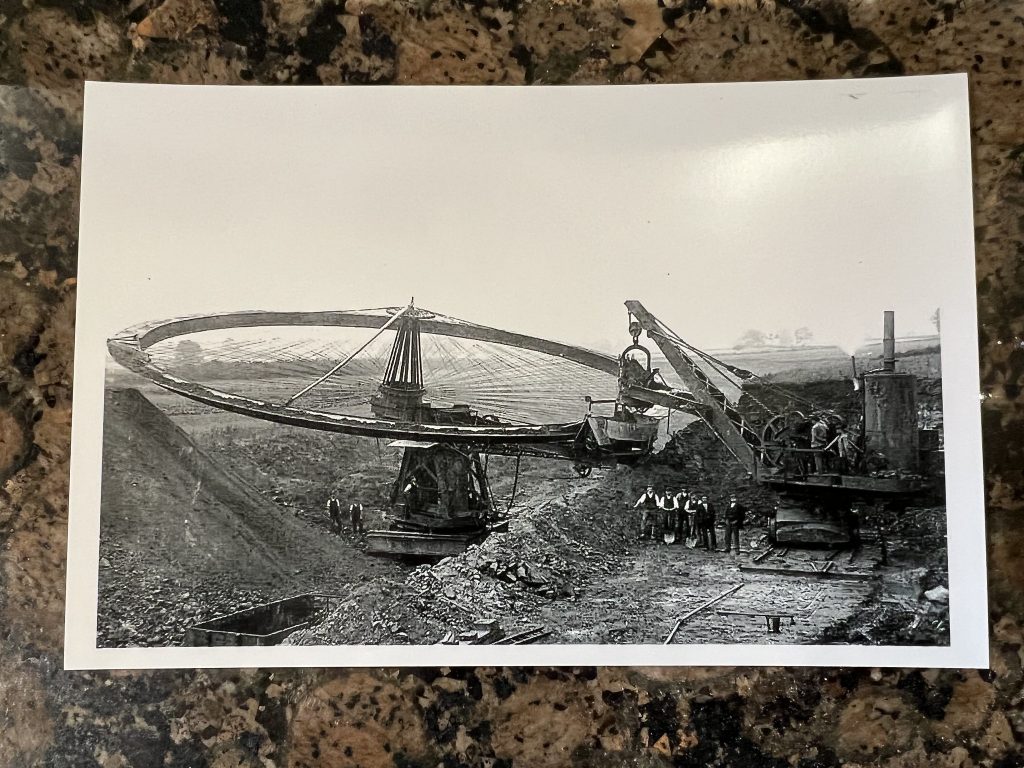Twywell hills & dales
A mining trial took place at Twywell Hills and Dales, a heading was driven but nothing more happened, further details are unknown.
Finedon Hill mine
This was Stantons first venture in the Wellingborough area; he obtained the lease in 1869. His first task was to reach the site near Sidegate Lane with the 2ft 6″ tramway, this was originally a horse traction way. A wooden frame bridge was installed under Sidegate Lane for this a tramway, heading towards the site of the mine was erected. A incline was worked by gravity on a pulley wheel at the top. The tubs were 5ft by 4ft by 2ft and held 40 cubic ft each, these were mostly made of wood, with multiple of these full bodies coming down it soon pulled the empties back up. Looking towards Nielsons sidings from the wooden bridge, this incline was originally worked by 6 large horses hauling the tubs up and down to the ironworks below.
Surface mining started in 1890, this was the typical plank and barrow method for loading the tubs. It is unknown if steam shovels were used for this site. By 1909 all shallow stone had been got, now it was time to commence the mining. A heading was driven just in front of the gravity haulage system, here it could attach tubs onto the system and send them on their way to the ironworks. We know around 1909 the 6 horse incline was changed for a steam power engine, this came from the Dale Colliery with its “master” as a package ! The mine heading was 8ft high and a pillar and stall design was used, if the haulage system near the mine was a endless haulage system which entered the mine this would make most sense and speed the workings up. The site was not the largest in the area it only stretched for two fields. Coming towards the end of its lease all the pillars in the mine were robbed causing large amounts of damage to the surface
By 1918 the lease had expired and all work came to a stop. There are no known remains of this mine due to later on surface mining excavation work, which re-worked the whole area. Only depressions across the field show the route the tramway once took. LIDAR scans show this particularly well.
Carrol spring
This area has been completely exhausted by large surface work , 10 adits were driven here originally but due to the fast development in steam shovels, the ore ended up being worked out by stripping shovels out.
A survey does exist for these trial adits, if the void from the mining does remain this is unknown. Was it later on worked out by deep drag lines? Today this site is on private property; the area has been completely filled with landfill waste.
Cogenhoe
We are very fortunate to have a large quote, for such a important peice of early history.
Operations at Cogenhoe began very early in 1858, both opencast & mining was used. The “Firs” a patch of woodland on the summit of the ridge southeast of the village was the place it began. A narrow gauge rope worked incline ran down to a point just south of the road to Grendon, where there was a tipping dock exchange point to the main line. There is a reference to the mines in the 1859 mining journal which says the bulk of the ore was got from open cast work.
Other than the above there is no more history known about these early underground workings. It is believed the under ground workings were later destroyed by larger later on surface mining machines efforts.
Old Barn close
Old Barn close started life as an open cast mine in 1906 it had various owners and growth over the years. The date the first adit was driven is unknown, these adits were driven in the north cliff face. We know the mine was operated by horses & the survey shows the workings was pillar and stall mining, all pillars are left in place. These pillars are much larger than usual design in this area. It is also worth mentioning all passages under highways have been stowed and neighbouring passages also, it is unknown if pipes have been installed in the stowing to allow drainage, if not a large volume of water could have formed. The mine closed on the 24th march 1914, this also matches the date on the abandonment plan. The surface work continued working until 1922.

Above is an interesting image taken of the west glebe surface mine. This shows a system used in the early days. This surface mine operated from 1897-1916,After closure this site became a landfill for house hold waste .
